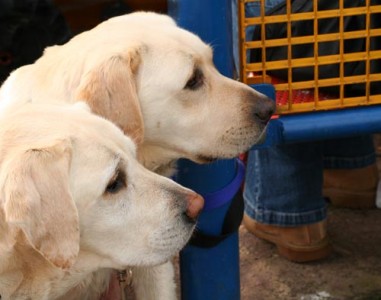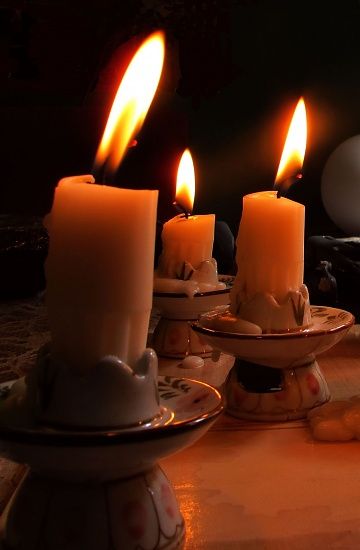
Side shots tend to look more like a record than an engaging picture.
• Loyalty - Waiting For Master •
Capturing attention with the dogs eyes
When we see a human our immediate focus is the face. Especially the eyes. It is just the same with a dog. Focus on the eyes and you invite the viewer into the shot. A catchlight in the eyes help too. They emphasises the dog’s expression and helps define its line of sight. Catchlights are the pin-points of bright light that reflect the eye. They bring the eye alive and help to animate the picture.
Pin-sharp focus on the dogs eyes and catchlight is a great way to draw in the viewer to your picture. If the catchlight is pointing at you the shot is even more engaging. Try to find ways to position yourself to capture these reflections.
Dogs eyes are appealing, along with other things
Your favourite pooch is more appealing if you are looking into its eyes. Eye contact with you while photographing will establish a rapport with your viewer in the picture. I think dogs have expressive faces. If you recognise a dogs mood in the face the dogs eyes will help you capture it.
A waggy tail is appealing too. Some of the best dog pictures are taken with an obvious waggy tail. You can often get a dog to show waggy tail enthusiasm by rewarding its participation. A little petting that the dog likes will get the response you want. It will also put some life into the dogs eyes.
The appeal of ‘doggyness’ often comes from the unbound joy-in-life shown by dogs. They love sharing fun with you. Try to capture them enjoying themselves. A favourite toy will help give a focus their behaviour for the shot. Try to make sure the toy is presentable. A photo can be ruined by a horribly chewed toy. It is distracting. Again, with toys get the dogs eyes in the shot.
The best moments to capture a dog are when it is showing affection. Dogs and children make especially cute compositions. Dogs who love kids really put over the feeling of a loving and loyal dog. If you can get the child’s and dogs eyes to meet that is especially appealing. The eye connection is emotive in a photo.
Record shot
The more the dog is taken from the side or looking slightly away the more the shot looks like a record shot. Dogs don’t seem to photograph well from the side unless lit to show off the body form. The side view tends to flatten the picture and makes the shot less appealing. Of course if you are taking a shot of a show dog then it is perhaps exactly what you want. If you do want this, you should arrange the lighting to come from the side of the shot – down the length of the body. That will help sculpt the body shape by creating shadows. Do not use on-camera flash. That will tend to flatten the body shape.
What is the point?
It’s worth thinking about what you are trying to achieve. If you want to see more of the body shape it is better to focus your shot from the face down the body. Make sure your camera is set up to have a deep focus (say, f11 to get a deep depth of field). Try to make the background simple, uncluttered. This will help keep the viewers attention on the dog, especially the dogs eyes.
Loyalty
Dogs love to lie at the foot of their most loved. If you can, make a picture of a dog at the foot of a relaxed family member. The dogs eyes are often soulful in this “loyalty” position. You could get a great photo. There is nothing more appealing to us than seeing protective love and affection.
Wild and free
Dogs love the wild and free moments in life. If you want to emphasis the wildness of a dog capture for the depth of blackness in the dogs eyes. Catchlights, when reduced to tiny spots, emphasise wildness. Pick up on other ‘wildness’ actions too. Tail down and low head and shoulders emphasise menace. A crouch in walking emphasises the hunting poise. One paw off the ground, frozen, alert, is another classic hunt/menace pose. Don’t forget the ‘ready-to-spring’ position – it is a great hunting pounce shot. It is often possible to capture that moment just before someone throwing a stick. Try to remember the dogs eyes when you capture that moment. Look for its line of sight to get the shot right.
Always leave room in front of your dog so they look like they have space to run into. If you bunch their head too close to the side of the picture it is not flattering. It also makes the dog look like it is about to crash into the side of the picture. And, this golden rule applies to the dogs eyes too. If they are looking away from you you must allow space in front of the face for them to look into. Otherwise the benefit of the line of sight will be lost.
Sleep and cuteness
Sleeping shots make great portraits. Concentrate on the lines of the dog. Show its relationship to the surroundings. Sleep often shows vulnerability. So try to find a background that brings it out. Dogs are pretty cute when asleep. However, try to take the shot from the same level as them. If you stand up for a sleep shot all the cuteness is lost and the flatness of the floor makes the dog look flat too.
Portrait work
For dog portraits, the way it is standing, sitting or moving is important. The simplest thing is to just stand there and snap away. But it is a bit hit and miss. When doing a portrait of a dog remember that the most effective shots are taken at its level. Get down to it and really get into its world. Try shooting nose to nose, catch it eating – work with it on its favourite toy. Try to find as many things that you can that complement its way of life down at its own level. Down on the floor with a dog you will capture the dogs eyes more intimately. You will also invite its approach to you. Dogs love you to share their world with them.
Incentives
Use toys, or props, that the dog will enjoy. It’s a good way to get the dog involved. It will also provide a secondary focus to the shot. Remember secondary items can be distracting. So don’t make them too big in the shot. Instead, use props to motivate your dog to play. Minimise the impact of the toy on the photo. Concentrate on the dogs behaviour.
The dog will want to be involved with your shoot. But, there is no use trying to “make” it do things. It must “want” to do them. Try giving treats at appropriate times when photographing them. This will encourage and reward them for the behaviour you want. It will help them be involved in your photography too. You will also get a better line-of-sight for the dogs eyes if you involve them. They will be more likely to look in your direction.
Much of your dog photography will be captures of the dog ‘doing its thing’. Be ready for the behaviour you want. Plan for it. The happy accident is when you have prepared for the shot by watching the dog. Then it does what you hope and you are all ready to click. Working with different dogs will get you different results. So be prepared to change your approach in different situations or with different moods of the animal. The very character of the dog will define the way it is pictured.
Photographing Dogs series links…
Photographing Dogs – Part 1 – Getting Started
Photographing Dogs – Part 2 – What to focus on.
Next article: Photographing Dogs – Part 3 – Getting the shots
Photographing Dogs – Part 4 – Practical Issues

Damon Guy (Netkonnexion)
Damon is editor of Photokonnexion. He has professional experience in photography, writing, image libraries, and computing. He is an experienced, webmaster and a trained teacher. Damon runs regular training for digital photographers.
See also:
Editors ‘Bio’ By Damon Guy :: Profile on Google+.




 Side shots tend to look more like a record than an engaging picture.
Side shots tend to look more like a record than an engaging picture.